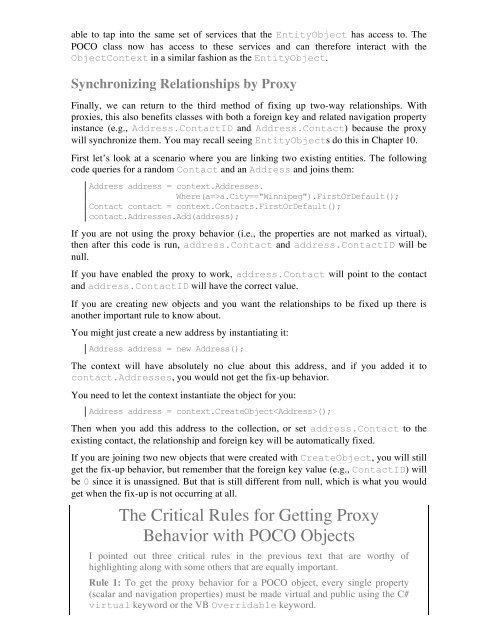Programming Entity Framework - Cdn.oreilly.com
Programming Entity Framework - Cdn.oreilly.com
Programming Entity Framework - Cdn.oreilly.com
Create successful ePaper yourself
Turn your PDF publications into a flip-book with our unique Google optimized e-Paper software.
able to tap into the same set of services that the <strong>Entity</strong>Object has access to. The<br />
POCO class now has access to these services and can therefore interact with the<br />
ObjectContext in a similar fashion as the <strong>Entity</strong>Object.<br />
Synchronizing Relationships by Proxy<br />
Finally, we can return to the third method of fixing up two-way relationships. With<br />
proxies, this also benefits classes with both a foreign key and related navigation property<br />
instance (e.g., Address.ContactID and Address.Contact) because the proxy<br />
will synchronize them. You may recall seeing <strong>Entity</strong>Objects do this in Chapter 10.<br />
First let’s look at a scenario where you are linking two existing entities. The following<br />
code queries for a random Contact and an Address and joins them:<br />
Address address = context.Addresses.<br />
Where(a=>a.City=="Winnipeg").FirstOrDefault();<br />
Contact contact = context.Contacts.FirstOrDefault();<br />
contact.Addresses.Add(address);<br />
If you are not using the proxy behavior (i.e., the properties are not marked as virtual),<br />
then after this code is run, address.Contact and address.ContactID will be<br />
null.<br />
If you have enabled the proxy to work, address.Contact will point to the contact<br />
and address.ContactID will have the correct value.<br />
If you are creating new objects and you want the relationships to be fixed up there is<br />
another important rule to know about.<br />
You might just create a new address by instantiating it:<br />
Address address = new Address();<br />
The context will have absolutely no clue about this address, and if you added it to<br />
contact.Addresses, you would not get the fix-up behavior.<br />
You need to let the context instantiate the object for you:<br />
Address address = context.CreateObject();<br />
Then when you add this address to the collection, or set address.Contact to the<br />
existing contact, the relationship and foreign key will be automatically fixed.<br />
If you are joining two new objects that were created with CreateObject, you will still<br />
get the fix-up behavior, but remember that the foreign key value (e.g., ContactID) will<br />
be 0 since it is unassigned. But that is still different from null, which is what you would<br />
get when the fix-up is not occurring at all.<br />
The Critical Rules for Getting Proxy<br />
Behavior with POCO Objects<br />
I pointed out three critical rules in the previous text that are worthy of<br />
highlighting along with some others that are equally important.<br />
Rule 1: To get the proxy behavior for a POCO object, every single property<br />
(scalar and navigation properties) must be made virtual and public using the C#<br />
virtual keyword or the VB Overridable keyword.

















